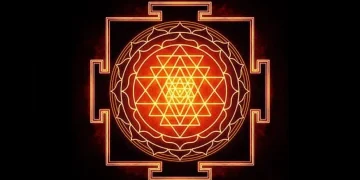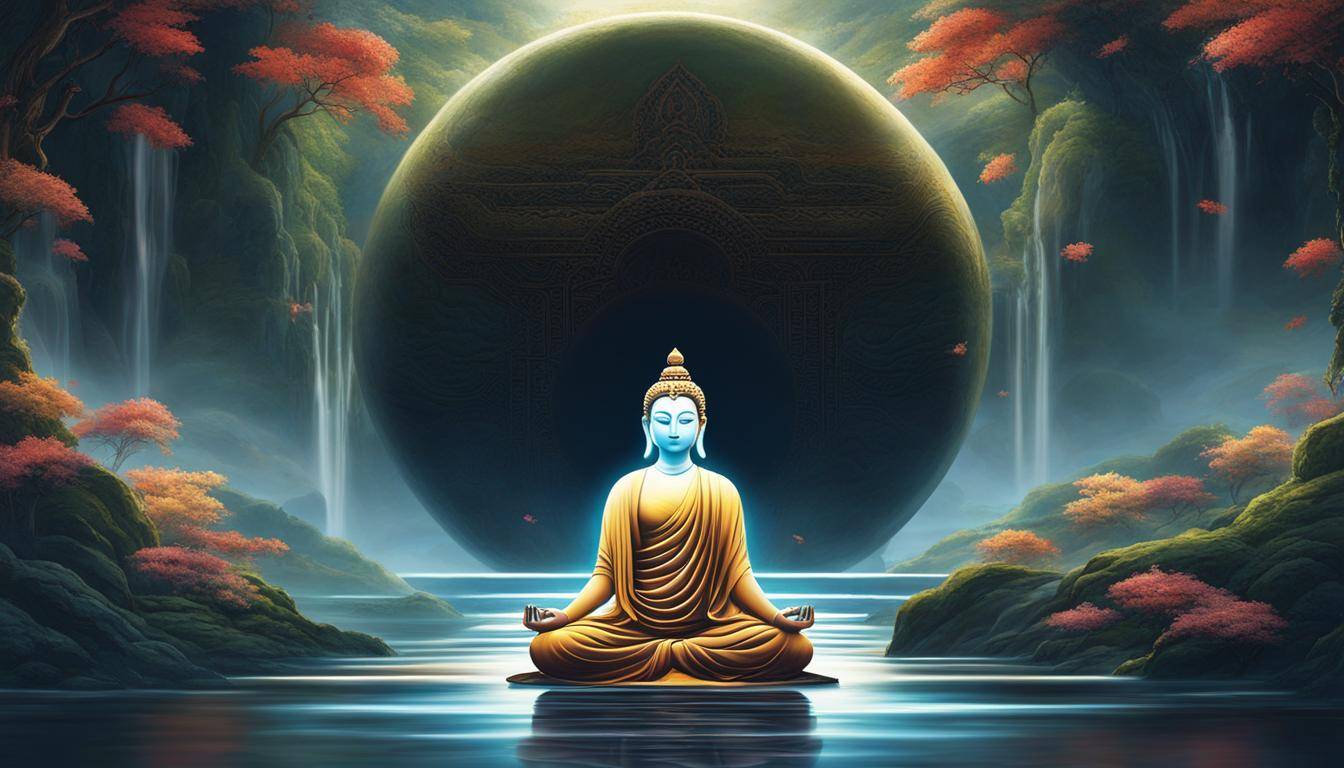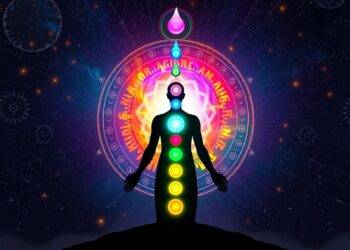Welcome to a journey of self-discovery and spiritual awakening. In the rich philosophy of Buddhism, the concept of chitta holds profound importance.
Chitta, often referred to as the heart-mind, encompasses the mind, consciousness, and mental states. It is a key element in meditation, mindfulness, and the path to enlightenment.
Let us delve deeper into the essence of chitta and its transformative power in your spiritual practice.
Key Takeaways:
- Chitta represents the mind and mental processes in Buddhist philosophy.
- Understanding the categories of the mind deepens our knowledge of chitta.
- Meditation allows us to tap into the power of chitta and cultivate mindfulness.
- Chitta plays a crucial role in the path to enlightenment and personal growth.
- By embracing chitta, we can experience a profound shift in consciousness.
The Four Categories of the Mind in Buddhist Philosophy
In Buddhist philosophy, the mind is divided into four distinct categories: buddhi, manas, ahankara, and chitta. Understanding the unique characteristics of each category is essential for gaining a deeper insight into the complexities of Buddhist philosophy.
Buddhi: The first category, buddhi, represents the intellect and embodies the logical dimension of thought. It is through buddhi that we engage in critical thinking, reasoning, and analysis, allowing us to make informed decisions and understand the world around us.
Manas: The second category, manas, extends beyond the confines of the brain and encompasses memory and intelligence throughout the entire body. It is through manas that we form perceptions, process sensory information, and generate thoughts.
Manas plays a crucial role in shaping our experiences and understanding of the world.
Ahankara: The third category, ahankara, is closely intertwined with the intellect. It gives us a sense of identity and individuality. Ahankara allows us to differentiate ourselves from others and develop a unique perspective. It is through ahankara that we establish a sense of self, shaping our beliefs, values, and personal narratives.
Chitta: The fourth and final category, chitta, represents pure intelligence without memory. It serves as the link between the mind and consciousness. Chitta is the cosmic intelligence that orchestrates all mental processes and experiences.
It is through chitta that we tap into the profound wisdom and universal interconnectedness that underlies our existence.
Understanding these four categories of the mind provides a foundation for comprehending the intricacies of Buddhist philosophy. Each category contributes to the overall functioning and development of the mind, shaping our perceptions, thoughts, and sense of self.
Through careful exploration and contemplation of these categories, individuals can deepen their understanding of their own mind and its role in the pursuit of enlightenment.

Unlocking the Power of Chitta in Meditation
Meditation is a transformative practice that holds the key to unlocking the power of chitta in your Buddhist journey. By delving into the depths of your mind and quieting the noise of the intellect, you open the door to connect with the pure intelligence of chitta.
Through the cultivation of mindfulness and focused awareness, you can observe your mental states, unravel the complexities of consciousness, and gain a deeper understanding of yourself.
During meditation, you will embark on a profound exploration of your inner landscape. As you sit in stillness, observe the thoughts, emotions, and sensations that arise. Through this process, you begin to unravel the patterns and conditioning of your mind, freeing yourself from negative mental states and limiting beliefs.
As you continue to deepen your meditation practice, you will experience the transformative power of chitta. This pure intelligence within you possesses the innate capacity to embrace positive qualities such as compassion, wisdom, and equanimity.
By nourishing and expanding the power of chitta through meditation, you pave the way for self-transformation and spiritual growth.
“Meditation is the art of diving deep within yourself, where the answers reside.”
– Ananda
In your meditation practice, embrace mindfulness as your guiding light. Be fully present in the here and now, observing each breath, sensation, and thought with non-judgmental awareness. Through this gentle observation, you develop an intimate relationship with your inner world, allowing for the emergence of self-realization and profound insights.
As you progress on the path of meditation, you will discover that chitta is not bound by the limitations of the egoic mind. It transcends the confines of the individual self and connects to the vast ocean of consciousness that unites all beings.
This realization brings about a profound shift in your perception and understanding of reality.
Unlocking the power of chitta through meditation is an essential aspect of the Buddhist path to awakening. It empowers you to go beyond the surface level of existence and tap into the infinite well of wisdom and compassion within you.

Allow yourself to fully embrace the transformative journey that meditation offers. Connect with the power of chitta, and experience the profound shifts in consciousness that arise as you delve deeper into your practice.
Embrace the power of meditation, unlock the hidden reservoir of chitta within you, and embark on a journey of self-discovery and spiritual awakening.
Chitta and the Path to Enlightenment
Chitta is closely associated with the path to enlightenment in Buddhism. As you deepen your understanding of chitta and cultivate mindfulness, you develop the ability to observe your thoughts, emotions, and mental states without attachment. This detachment leads to a greater sense of inner peace, clarity, and wisdom.
Through continued spiritual practice, you can gradually dissolve the identification with the egoic self and access the true nature of chitta, which is pure consciousness. This awakened state is the ultimate goal of the Buddhist path to enlightenment.
“You do not have to be a Buddhist to walk the path of enlightenment. It is a journey available to anyone who seeks inner peace and awakening.”
The Transformative Power of Chitta in Spiritual Practice
Chitta, the heart-mind of Buddhism, holds the transformative power that can truly shape your spiritual practice. Through the cultivation of mindfulness and awareness, you have the ability to witness and understand your mental states, gradually releasing the grip of negative emotions that hinder your growth.
Imagine a process where you gently loosen the chains of attachment, aversion, and ignorance. As you do so, you purify and refine your chitta, allowing for a greater sense of clarity and compassion to blossom within you.
This transformation not only impacts your individual journey but also connects you deeply with others and the world around you.
Chitta empowers you to experience personal growth and self-discovery, serving as a guiding force in the development of an awakened and enlightened consciousness.
“The transformation of chitta brings forth a profound change in our perception of reality. It is an awakening that expands our awareness, illuminating the path to enlightenment.”
– Master Kaira Dhara
Conclusion
In conclusion, chitta is a fundamental concept in Buddhist philosophy and a central aspect of spiritual practice. By delving into the intricacies of the mind and consciousness, Buddhism emphasizes the importance of understanding chitta in order to achieve personal growth, self-discovery, and ultimately, enlightenment.
Through the practice of mindfulness and meditation, individuals can cultivate a deeper connection with their chitta, leading to a profound transformation in their consciousness.
By observing and understanding their mental states, practitioners can gradually dissolve negative emotions and attachments, allowing for the emergence of clarity, wisdom, and compassion.
Embracing chitta as an integral part of Buddhism offers a transformative journey towards liberation and enlightenment. By tapping into the power of chitta and aligning one’s spiritual practice, individuals can awaken to their true nature, experience a profound shift in consciousness, and embark on a path of self-transformation and deep spiritual fulfillment.
FAQ
What is chitta in Buddhism?
Chitta is one of three terms used in Buddhism to refer to the mind, along with manas and viññāṇa. It represents one’s mindset or state of mind and is closely related to volitions and cognitive and emotional conditions.
How does chitta relate to meditation?
Chitta plays a vital role in meditation by quieting the intellect and allowing practitioners to tap into the deeper layers of the mind. Through mindfulness and focused awareness, meditators can observe their mental states and cultivate a deeper understanding of themselves and their consciousness.
What is the connection between chitta and enlightenment?
Understanding chitta and cultivating mindfulness are crucial for practitioners on the path to enlightenment. As individuals deepen their understanding and develop mindfulness, they can observe their thoughts and emotions without attachment, leading to greater inner peace, clarity, and wisdom.
How does chitta transform spiritual practice?
Through the cultivation of mindfulness and awareness, individuals can observe their mental states and gradually dissolve negative emotions. This process allows for the purification and refinement of chitta, leading to greater clarity, compassion, and connection with others and the world.




























































